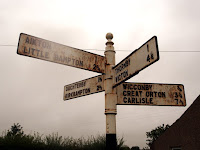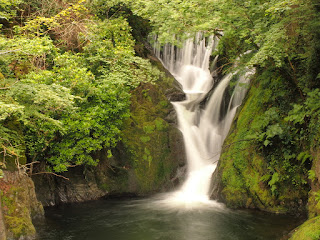 |
| Durham |
The second part of our recent holiday involved venturing
into the north of England which, it has to be said, does get a lot of bad press
(principally from those who live in the more prosperous south of the country).
Yes, it is noticeably colder, the accents are harsher and sometimes incomprehensible,
and the food – well, it has improved in recent years. And it is best to avoid
the populous industrial areas …
 |
| Chester |
But lurking just over the northern Welsh border before
hitting those populous industrial areas of Liverpool and Manchester is some good
countryside and beautiful towns like Chester. Not only historic but a big shopping centre, mainly Tudor-style buildings that have a covered walkway on
the first floor to provide two levels of shops. Both attractive and practical,
plus a good sprinkling of unique shops. Many town centres predominantly have national
chain shops so pretty much every High Street (invariably the name of the main shopping street!) feels the same. Boring!
 |
| Blackpool pier |
Our aim on this trip was to get to the very north of England
where some of Vicki’s ancestors came from. This meant a quick trip up the M6 motorway
which wends its way between Liverpool and Manchester and provides access to
many other industrial centres – very, very busy and hard to avoid. We finally
escaped to the coast at Blackpool. Despite its fame as a seaside resort it isn’t
attractive by any means. Poor and slightly rundown, plenty of large venues advertising
shows, but not very busy on a cold mid-summer evening. The famous pier is mainly
a large pub with a lot of games machines, but sneak through the pub to its viewing deck and the view is out to sea
where there is a line-up of wind turbines. Interesting, but probably won't make it onto our list of highlights.
 |
| Out to sea from Blackpool promenade |
 We ventured into the wilds of the famous “Lake District”. We
were surprised to find some very quiet, narrow roads, remote farms, steep
mountain passes (not “real” mountains, of course!), and pretty lakes. A few
forests and some grand lodges. It is lovely and peaceful countryside, at least
until you near the lakes when you hit bumper-to-bumper traffic queues. The main
tourist areas like Keswick on Derwent Water (lake) were heaving with people and
cars. Luckily there was no chance of finding anywhere to park our car so we
sprinted onwards at a snail’s pace. Up in the hills it was more pleasant, like
at the Castlerigg standing stones or over some of the remoter passes. It would
be a lovely area to visit in the off-season, though it would be cold and bleak
in winter.
We ventured into the wilds of the famous “Lake District”. We
were surprised to find some very quiet, narrow roads, remote farms, steep
mountain passes (not “real” mountains, of course!), and pretty lakes. A few
forests and some grand lodges. It is lovely and peaceful countryside, at least
until you near the lakes when you hit bumper-to-bumper traffic queues. The main
tourist areas like Keswick on Derwent Water (lake) were heaving with people and
cars. Luckily there was no chance of finding anywhere to park our car so we
sprinted onwards at a snail’s pace. Up in the hills it was more pleasant, like
at the Castlerigg standing stones or over some of the remoter passes. It would
be a lovely area to visit in the off-season, though it would be cold and bleak
in winter. |
| Castlerigg |
Our evening was spent at Maryport, an east coast fishing
port well past its heyday. Once again there was a line-up of wind turbines out
to sea, with an attractive port area to wander around before dinner. A smallish town but with numerous pubs, probably reflecting that it had
been a busy port.
The purpose of being in this area was to visit the haunts
of Vicki’s ancestors - her Mum's great-great-great grandfather moved to the small town of Wigton from Scotland before 1830. It was unfortunate that this was our 'rain day' - we'd been so lucky with the weather until now. We didn't spend much time hanging about - several photos were taken from the car window, and the others from under an umbrella.
 |
| Hadrian's Wall |
From Carlyle we followed the very straight Roman roads alongside
Hadrian’s Wall across to Newcastle on the west coast. The Wall is still intact
in many places, looking just a little more impressive than the local stone
walls around paddocks, with the odd remains of a watchtower or barracks. There
are quite a few stone farmhouses in the area and it is obvious from where they obtained
their building material! Running along both sides of the Wall is a ditch
that is clearly visible. This was another means of defense, both from the northern
tribes and those on the southern side. Effectively the Wall formed a protected
corridor from a supply port on the east coast to another port on the west. At
intervals along the Wall were gates to let people through.
 |
| Durham |
We spent more time than we’d have liked in Newcastle
searching for a church where some ancestors had married - there were three with a similar name and our GPS (affectionately known as Gary .... Gary Garmin .... get it?) took us on quite a tiki tour - we didn’t find what we were looking for, which lead us to the conclusion that maybe they had in fact been married in the main cathedral, which has the same name. I presume Newcastle has some redeeming features, but we didn’t
see any as we trundled along the motorways skirting the centre of town - late afternoon on a Friday (most unfortunate!).
Just lots of concrete. Luckily it isn’t too far to Durham which is the polar
opposite – a beautiful old city on a bend of a river dominated by Durham Cathedral.
Cute cobbled streets, street markets, interesting shops, attractive old buildings,
pretty location with the river – no wonder we loved it here. It would be a great
place to live, except for the cold!! And a special mention goes out to Vicki’s
pasta: we found a real Italian restaurant, staffed by Italians, and the best
pasta dish Vicki has had out of Italy.
 |
| On the river at Durham |
A sunny August weekend turned out not to be the best time to
drive down the coast. This is Captain James Cook country and there are several
historic and pretty ports, such as Whitby (where Dracula was written and
partially set) and Staithes. Far too many people around and we couldn’t get enthusiastic about parking miles away and walking alongside grizzly kids and pushchairs. So we avoided Scarborough (apparently
that was a good decision) and headed across the North Yorkshire moors to
another pretty historic town for the night – Knaresborough, just west of York.
Our last Airbnb (a good one again) and our last pub dinner (a good one too) for
a while. Clearly lots more worth seeing in this area, including York, so
another holiday beckons.














